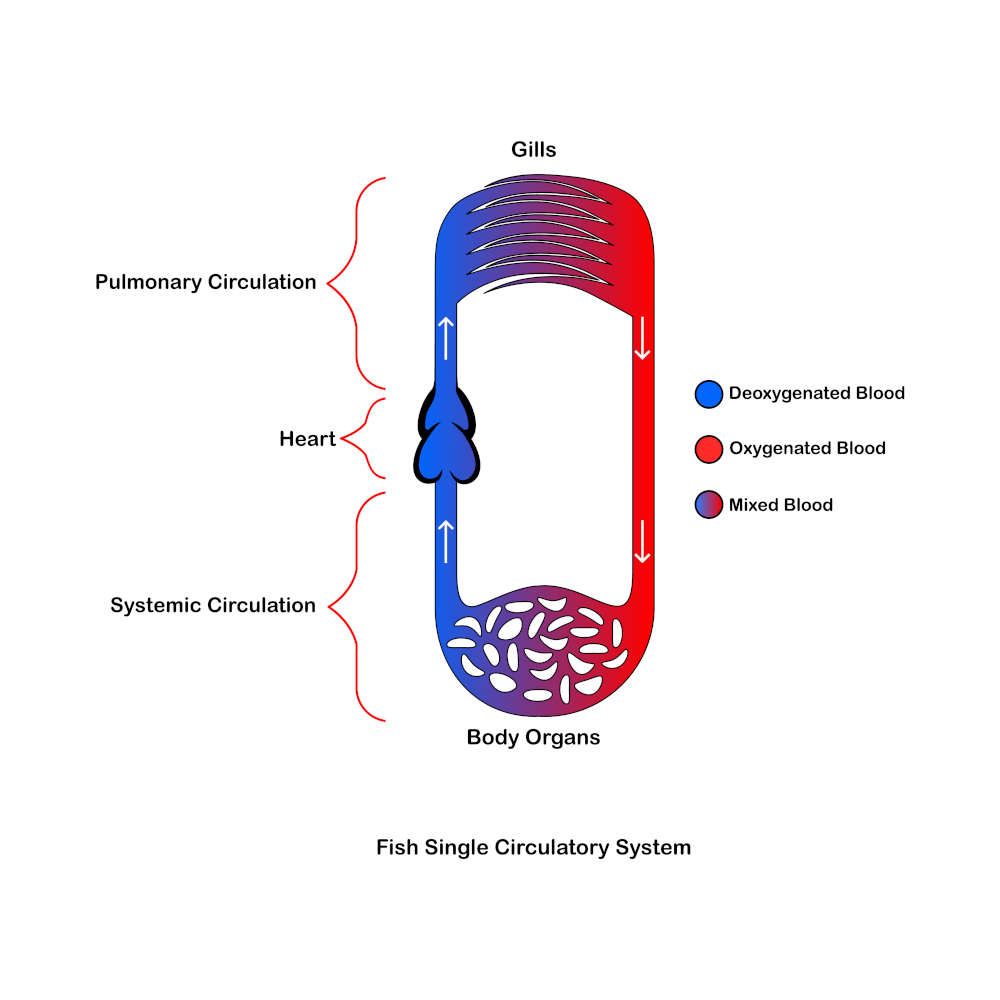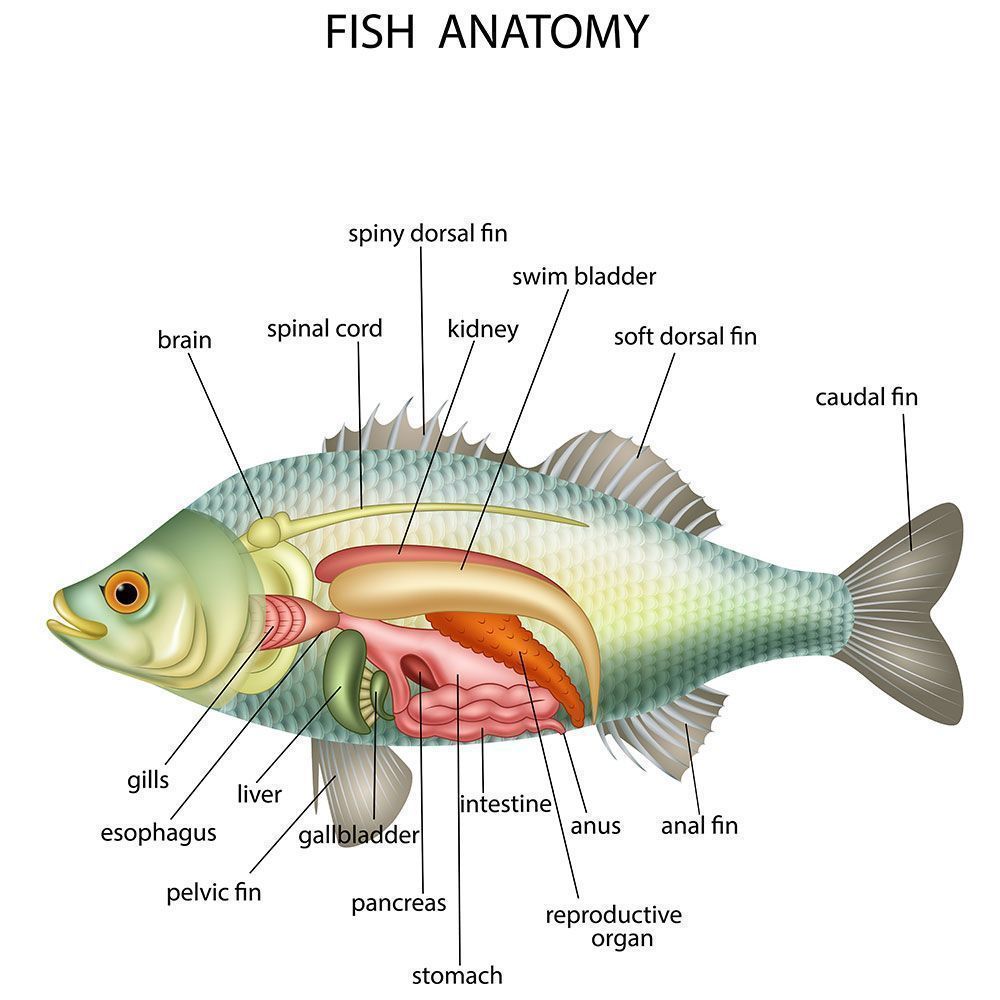All fish have a heart comprising of two chambers, atrium and ventricle, and two compartments, sinus venosus and outflow tract. Having a fish heart does not depend upon the size of the fish. The deoxygenated blood from the body is sent through all the compartments, oxygenated in the gills, and returned to the blood capillaries in the fish body.
Did you know that the blue whale has the biggest heart among all fish – with a whopping weight of 1000 pounds?
That’s equivalent to the weight of a dairy cow!
In fact, with every heartbeat, it pumps 60 gallons of blood – compared to human beings, which is only 2.4 oz per beat!
The fish heart is called the branchial heart since its primary role is to pump deoxygenated blood through the ventral aorta to the branchial gills and the rest of the body.
What is the Difference Between a Fish Heart and Heart of Other Species?
What is the difference between a Fish Heart and Bird Heart?
Fish heart is two-chambered whereas the hear of mammals and birds are four-chambered.
This is because fish don’t need rapid oxygen replenishment and delivery to their tissues and have comparatively lower metabolism. Fish blood, after passing through the gills, doesn’t turn repressurized because there’s no need for swift oxygen need.
Due to the lack of enough chambers, the oxygenated and deoxygenated blood gets mixed, and the fish heart can never pump highly oxygenated blood to its body parts. Thus, energy production is much slower in fish, which results in them being cold-blooded beings.

Mammals and birds, on the other hand, have high metabolism and immediate and high oxygen requirements. So, their hearts send the blood to another set of chambers to repressurize it so that the blood flows fast and reaches the tissues ASAP.
Due to more chambers, the impure and pure blood are also perfectly separated. This makes them warm-blooded.
Fish hearts may not be as strong or complex as human hearts, but they definitely play all the vital roles in keeping fish alive. It has the same ability to oxygenate blood and filter out wastes and carbon dioxide.
In any case, the fish needs a swift flow of blood (for environmental reasons or anything else); its endocrine system pumps hormones to accelerate the heart pumping. It further dilates small arteries to support better circulation and diminish resistance.
What is the difference between a Fish Heard & an Invertebrate Heart?
When compared to invertebrates, fish hearts are much more complicated. Invertebrate heart only has a tubular structure that pumps out hemolymph (blood equivalent for insects). Only cockroaches, mollusks, and cephalopods are exceptions with chambered hearts.
With that said, if you want to dive into the interesting details about fish hearts, keep scrolling!
What is the Anatomy of a Fish Heart?
Fish heart actually has two chambers, i.e., an atrium that receives blood from the rest of the body and a ventricle. It pumps blood to the rest of its vital organs and tissues in the entire body.
The fish heart also has different entry and exit “compartments.” Some may count these compartments as chambers and call it a three or four-chambered heart. In this case, the atrium and ventricle are referred to as the “true chambers,” while the rest are labeled as “accessory chambers.”
What are the different chambers in a fish heart?
1. Sinus venosus
This reservoir has a thin wall and little cardiac muscle. It gathers deoxygenated blood from the entire fish body via cardinal and hepatic veins.
2. Atrium
This true chamber has a thicker muscular wall than the sinus venosus. It receives the blood from the sinus venosus and pushes it to the ventricle. The atrium is filled with blood due to suction, which is a result of the stiffness of its pericardium and other adjacent tissues.
Venous blood is sent back to the atrium with the help of systolic ventricular contraction due to a drop in intrapericardial pressure. The pressure, when transmitted through the walls of the atrium, creates an inspiratory effect.
3. Ventricle
The ventricle is a muscular, thick-walled chamber that pumps blood to the next compartment. This portion of the heart looks tubular in elongated fish, triangular-bottomed with a pyramidal shape in some, and like a sac in many marine fish.
4. Outflow tract (OFT)
The tract leads to the ventral arteriosus (mainly found in primitive fish species). It also includes tubular bulbus arteriosus or conus arteriosus, or sometimes both. The conus arteriosus directs the blood flow to the aorta, but the bulbus arteriosus does not.
What are the different valves in a fish heart?
There are a few ostial valves in the heart, as follows:
- The one between the sinus venosus and atrium is known as the sino-atrial valve.
- The next one between the atrium and ventricle is known as the atrioventricular valve.
- Another one is between bulbus arteriosus and ventricle – known as bulbo-ventricular valve.
Ostial valves have flap-shaped connective tissues that are. During contractions, the respective valve closes so blood doesn’t flow back into the previous compartment. There are also inconsistent numbers of semilunar valves in the conus arteriosus.
What is the Gas Exchange Process of a fish heart?
After that, the ventral aorta sends blood to fish gills. In the gills, gas exchange occurs, i.e., the blood is oxygenated, and carbon dioxide is expelled. This blood is then delivered to the remaining body via the dorsal aorta.
What are the Facts About Fish Heart?
Here are some more interesting details about fish heart you should know about:
1. The four fish heart compartments aren’t linear in the adult fish. Instead, they form an S-shape where the last two compartments lie above the previous two. This is common in ray-finned and cartilaginous fish.
2. The conus arteriosus of teleosts is extremely tiny. So, it’s called a subpart of the aorta instead of the heart itself. It’s called bulbus arteriosus and works as a specialized ventral aorta.
3. In elasmobranchs, conus arteriosus is known as the fourth heart chamber.
4. The performance of fish heart depends on the heart rate and stoke volume. With every heartbeat, the fish’s heart ventricle pumps body to the entire body.
The volume of blood pumped is called stroke volume, while the time taken for every heartbeat is called heart rate. Fish heart rate depends on circulatory substances, cardiac filling, muscle influence, and cardiac pacemaker.
How do you identify a fish heart?
The fish heart can be easily identified. It is located just below the gills. The heart is usually pretty small compared to the fish body and triangular-shaped with a dark red to reddish brown color.
It also has a simple and single circulatory system, i.e., the blood flow from the heart to the gills. Then, the gill capillaries take blood throughout the body tissue capillaries. Like any other vertebrate, it’s a closed circulatory system.
A word from FishInAquarium
The fish heart is a vital organ necessary for blood circulation and the fish’s survival – just like human beings. While it’s not as complicated as for most warm-blooded vertebrates, it comes with its unique role and functionality.
Despite being so simple, it stands out by keeping an entire being alive in its own unique way. So, if you have an aquarium, make sure you feed your fin buddies specific food that prevents fish heart ailments.
If you’re satisfied with everything you learned here, make sure to share it with your enthusiast friends. Let them unravel the anatomy of the fish heart!
And if there are any more questions, drop us an email, and we’ll have you covered!


